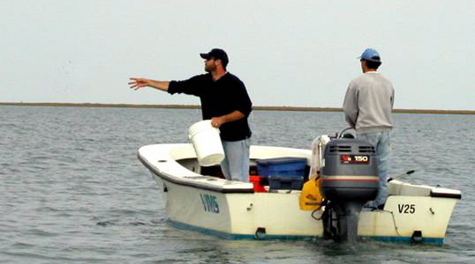Orth receives VA Outstanding Scientist Award
Governor Northam announces recipients of 2018 STEM honors
Professor Robert “JJ” Orth of the Virginia Institute of Marine Science has been honored as one of Virginia’s three Outstanding Scientists for 2018. The awards were announced by Virginia Governor Ralph Northam and Richard Conti, Chief Wonder Officer at the Science Museum of Virginia.

“Celebrating the academic excellence and entrepreneurial spirit of these Virginians helps showcase how STEM innovations tie in to our everyday lives,” said Governor Northam. “It also highlights the profound contribution that STEM makes to Virginia families and our economy.”
“The work these award winners have produced is not only inspiring, but also life changing,” added Conti. “Too often we don’t stop to think about the people behind the innovations and technology that are commonplace in our lives.”
Also lauding Orth was VIMS Dean and Director John Wells. “JJ is an internationally recognized leader in seagrass ecology who uses cutting-edge research to solve real-world problems,” he says. “Recent successes in restoring seagrass to Chesapeake Bay and Virginia’s Eastern Shore depend to a large part on his tireless efforts over the past 40 years. He is highly deserving of the Governor’s honor.”
A long and fruitful career
Orth’s career at VIMS began in 1969 when he enrolled as a graduate student to study the myriad animals that burrow beneath seagrass beds. After earning his Master’s at VIMS and his Ph.D. from the University of Maryland, Orth returned to VIMS as a faculty member in 1974.
Now one of VIMS’ most accomplished professors, Orth has literally helped sow a worldwide effort to restore and maintain seagrasses as key components of coastal marine ecosystems. These submerged flowering plants—in trouble worldwide due to nutrient pollution and other factors—provide habitat and nursery grounds for fish and crabs, serve as food for waterfowl and other animals, clear the water by reducing wave action, absorb excess nutrients, and reduce shoreline erosion. They are also an excellent measure of the overall condition of Chesapeake Bay and other coastal waters because their health is closely linked to water quality.
“Seagrasses serve as ‘coastal canaries’,” says Orth, referring to the longstanding practice of using canaries as “biological sentinels” to gauge air quality in coalmines. The recent increase in seagrass abundance in Chesapeake Bay—up 8% between 2015 and 2016, continuing a positive trend initiated in 2012—thus bodes well for ongoing efforts by state and federal partners to improve the health of the nation’s largest estuary.
Monitoring for management and education
Annual values of seagrass acreage in Chesapeake Bay come from VIMS’ Submerged Aquatic Vegetation Monitoring and Restoration Program. Created by Orth in 1978, the “SAV Program” is now the de facto yardstick for measuring and sustaining progress toward the Chesapeake Bay Program’s restoration goals.

A long-time colleague, Dr. Bill Dennison of the University of Maryland Center for Environmental Science, adds “Bob has worked tirelessly to make his science available for management and policy,” including “innumerable trips to Annapolis to participate in Chesapeake Bay Program activities.”
Dr. Linda Schaffner, Associate Dean of Academic Studies at VIMS, notes that Orth’s research and advisory activities have also benefitted several generations of VIMS graduate students. “By involving his many students in the hands-on worlds of science and policy,” she says, “he exemplifies all that we strive to achieve in our School of Marine Science.”
The “Johnny Appleseed” of seagrass
The SAV Monitoring and Restoration program at VIMS has also served as a model for the development of similar programs around the world. Indeed, Orth has been called the “Johnny Appleseed” of global seagrass restoration efforts, sharing lessons learned in Virginia with colleagues and governments from Scandinavia to Australia.

The restored seagrass beds are also the site of Orth’s most recent collaboration—a partnership between VIMS, The Nature Conservancy, the Virginia Marine Resources Commission, and the Virginia Coastal Zone Management Program to restore the tasty bay scallops that once called the beds home.
In 2013, Orth hosted a visit to these restored seagrass beds by Leo Mosgaard Nielsen, manager of the Danish consulting firm Multidyk; Swedish entrepreneur Per Nyström; and Dr. Eduardo Infantes, a Spanish post-doctoral research associate. The trio’s visit was part of NOVAGRASS, a collaborative international effort funded by the Danish government to refine and scale-up methods for seagrass restoration.
“After seeing the success JJ and his colleagues have had here with seedings,” said Mosgaard Nielsen, “we think we can adapt their methods to large-scale eelgrass restoration projects in Denmark and other areas nearby.”
“Bob has been a global ambassador for Virginia,” says Dennison, and “a most deserving recipient of the Virginia Outstanding Scientist Award. [He] is indeed an outstanding scientist, within and beyond Virginia.”

Other STEM Award winners
Overall, VIMS STEM Award program honored six individuals for 2018. Joining Orth as recipients of Outstanding Scientist awards were Drs. Arun J. Sanyal and M. Samy El-Shall of Virginia Commonwealth University. Also honored were STEM Catalyst winner Jack Ross and STEM Phenom winners Prathik Naidu and Ana Humphrey. The Catalyst award recognizes citizens whose passion and ingenuity inspire others to improve the world. The Phenom award recognizes a student who applies STEM principles to make the world a better place.
The six 2018 honorees received their awards at the Science Museum of Virginia on March 1. The Virginia Outstanding STEM Awards ceremony is made possible by the generous support of Altria.



